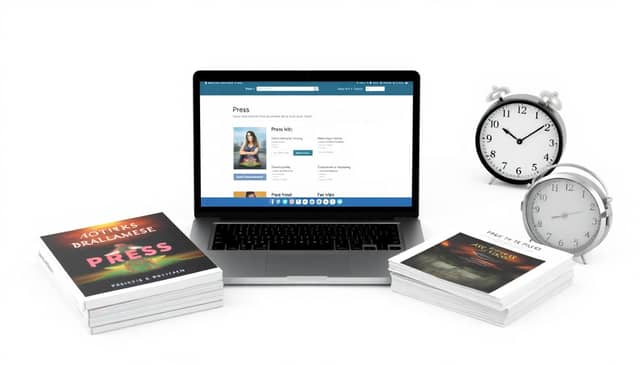Table of Contents
Putting together an author press kit can feel daunting—trust me, you’re not alone if you’re thinking, “Where do I even start?” We’ve all scrolled through confusing examples that leave us feeling more lost than inspired.
Stick around, though, because I’m gonna walk you through clear examples and practical tips that’ll make assembling your author press kit a breeze. You’ll soon be creating an appealing, user-friendly toolkit that’ll help you stand out and impress the press.
Ready? Here’s a sneak peek at the simple steps we’re about to cover.
Key Takeaways
- Study successful author press kits like J.K. Rowling’s and Celeste Ng’s for inspiration on key elements: bios, book details, and headshots.
- Your press kit should include: a short author bio, professional headshots, current book info, positive reviews, and clear contact details.
- Create your kit using a simple, clean layout, either embedded directly on your website or as an easily downloadable PDF.
- Make downloads user-friendly by placing the press kit prominently on a dedicated page, ensuring files load quickly and links are working correctly.
- Add FAQs and talking points to help journalists find interesting topics easily.
- Regularly update your kit with fresh content, visuals, and any new milestones—keep it accurate and relevant.

Step 1: Review Examples of Successful Author Press Kits
When starting your author press kit, the easiest way to get ideas flowing is by reviewing some successful examples from well-known authors. A strong author press kit clearly communicates who you are and why your work deserves attention from media and readers alike.
Take, for instance, author J.K. Rowling. Her press kit includes detailed press releases for upcoming projects, high-resolution author headshots, and thorough descriptions of her books. Having easily accessible information makes it effortless for journalists to cover her latest work or events.
Another excellent example comes from Celeste Ng, author of Little Fires Everywhere. Celeste goes the extra mile by sharing personal anecdotes and discussion points, giving media professionals interesting angles and conversation starters.
By analyzing several press kits, notice specific elements like author bios, book summaries, headshots, and contact information, and pay attention to how the authors organize this information. Keep track of features you find useful and relevant to your situation and note them down as you start assembling your own kit.
Step 2: Include Essential Components for an Author Press Kit
Before diving headfirst into writing your author press kit, be sure you’ve included all the key components that make it both complete and effective. Here are crucial elements you’ll always want to have:
- Short Author Bio: Provide a concise paragraph highlighting who you are, your most important achievements, and anything unique that distinguishes you from other authors. For ideas on crafting a compelling bio, check out these short author bio examples from successful authors.
- High-Resolution Headshots and Book Images: Always include clear, professional photos of yourself and your book covers, ideally at least 300 dpi resolution. Journalists will appreciate ready-to-use images for articles, blog posts, and reviews.
- Current Book Information: Share up-to-date details such as book titles, formats (ebook, paperback, audiobook), selling price, and where readers can purchase your books (preferably linking to major retailers).
- Testimonials and Reviews: Gather positive quotes or short reviews from credible media sources, popular bloggers, or notable influencers in your genre. These lend authority and credibility to your work.
- Contact Info & Social Media Links: Clearly mention your email address, website URL, and active social media profiles. Around 78% of authors regularly use social media to stay visible and connected, making this step key for your outreach.
Covering these bases ensures journalists, readers, and influencers have the basic elements they need without hunting around online, dramatically increasing your chances of coverage and engagement.
Step 3: Choose a User-Friendly Design and Format
While the content in your press kit takes center stage, keeping it visually neat, intuitive, and easy-to-navigate is crucial. Journalists and busy readers will appreciate your efforts, increasing the odds they’ll cover and promote your work.
An increasingly popular choice is creating an interactive, online author press kit right on your website, where media or readers can quickly browse or download necessary files, images, and details. Studies show a polished, easy-to-find online presence is key for author marketing strategies moving forward into 2025.
Stick to straightforward layouts with clear headings, concise wording, and visually appealing fonts that reflect the tone and genre of your writing. Consider using a website builder specifically designed for authors to achieve a professional yet simple appearance.
If you’re not tech-savvy, a downloadable PDF hosted on your website or platforms like Dropbox or Google Drive also works perfectly well. Just make sure the document is easily accessible and clearly labeled to avoid unnecessary confusion or frustration.
In short, your press kit doesn’t need flashy bells and whistles—just a clutter-free, easy-to-access, and pleasantly readable format will do the trick and help your author brand and book stand out from the crowd.

Step 4: Provide Easy Access and Sharing Options
Making your author press kit simple to access and share is one of those underrated tricks that saves everyone time and headaches. Let’s face it: nobody has patience to dig through confusing website menus or wait forever for large files to download.
First off, host your press kit prominently on your website, ideally on a clearly marked “Press” or “Media” page, making it a breeze to find. Considering that enhanced author websites and convenient online presence are key for effective marketing these days, it’s smart to keep your resources front and center.
Use direct download links or cloud storage services like Dropbox or Google Drive for sharing large files like high-resolution images or PDFs. This saves people from email attachment frustration (we’ve all been there).
Social sharing buttons are also a must-have—you want journalists and fans to be able to easily spread the word. With over 78% of authors using social media at least weekly, harnessing platforms like Facebook, Twitter, Instagram, and LinkedIn can boost your visibility without causing extra work for others.
Finally, always test your link and downloads yourself before publishing your press kit online. Nothing annoys busy media professionals more than broken links or outdated files that don’t load right.
Step 5: Prepare Your Press Kit for Media Engagement
Having a great press kit is nice, but making it easy for media folks to grab exactly what they need is even better. Your kit should anticipate common questions and offer quick, useful info to encourage coverage and simplify the journalist’s job.
Consider preparing a Frequently Asked Questions (FAQ) section within your kit, addressing things like book genre, page count, target audience, and publication date. Journalists often skim these first, so it helps if answers are crystal clear and easy to spot at a glance.
Journalists also appreciate story angles and direct quotes they can pull quickly. Include conversation starters or talking points to spark ideas for book reviews, podcast spots, or feature articles—think of them as friendly prompts, like witty or intriguing snippets about your inspiration or background.
Provide ready-to-use elements like short and long book blurbs optimized for searchability, keywords relevant to your book category, and engaging visual content. For example, if you’re publishing children’s literature, be sure your press kit includes attractive visual elements and maybe some creative topics for kids to write about that tie into your story.
Clearly displaying contact details is also essential—nothing fancy, just bold and clear. Make yourself easily reachable via email and social media to swiftly reply to journalist inquiries.
Step 6: Regularly Update Your Author Press Kit
Creating your author press kit isn’t just a set-it-and-forget-it task—think of it like watering your houseplants; a little check-up here and there keeps it from wilting away.
Regularly check and revise your press kit to reflect current projects, latest books, fresh accolades, or new events you’re participating in. Outdated or inaccurate information can cause missed opportunities or media confusion.
If your photos or book covers start looking dated (let’s be honest, we’ve all changed hairstyles or fashion sense a bit), make sure you update those visuals promptly with high-quality replacements. Offering fresh, high-resolution images signals professionalism and shows media you’re actively involved in your career’s trajectory.
Stay aware of trends or new components that other successful authors include in their kits—maybe it’s an author Q&A video, a new media release about your next book launch, or even testimonials you’ve recently collected. Keeping your press kit tuned up puts you ahead of the curve and gives media professionals the assurance they’re working with accurate, relevant content.
Schedule reminders once a quarter to do quick check-ins and keep things fresh, because nobody wants to be the author still showcasing book reviews dated from several years ago.
FAQs
Your author press kit should feature your professional author bio, high-resolution author and book images, recent press releases, contact details, book excerpts, reviews or endorsements, and straightforward methods for media to access and share the information.
Updating your author press kit every few months or whenever significant changes occur, such as a new book launch or noteworthy media coverage, helps ensure the content stays timely, relevant, and valuable for media and professional contacts.
You can host your author press kit as downloadable PDFs or files clearly accessible from the “Media” or “About” section of your official website. Providing direct download links facilitates quick access for media representatives and influencers.
Keep design clear and simple by using headings, bullet points, and white space for readability. Choose professional fonts and colors matching your author branding so media contacts can easily view and use the provided material.



